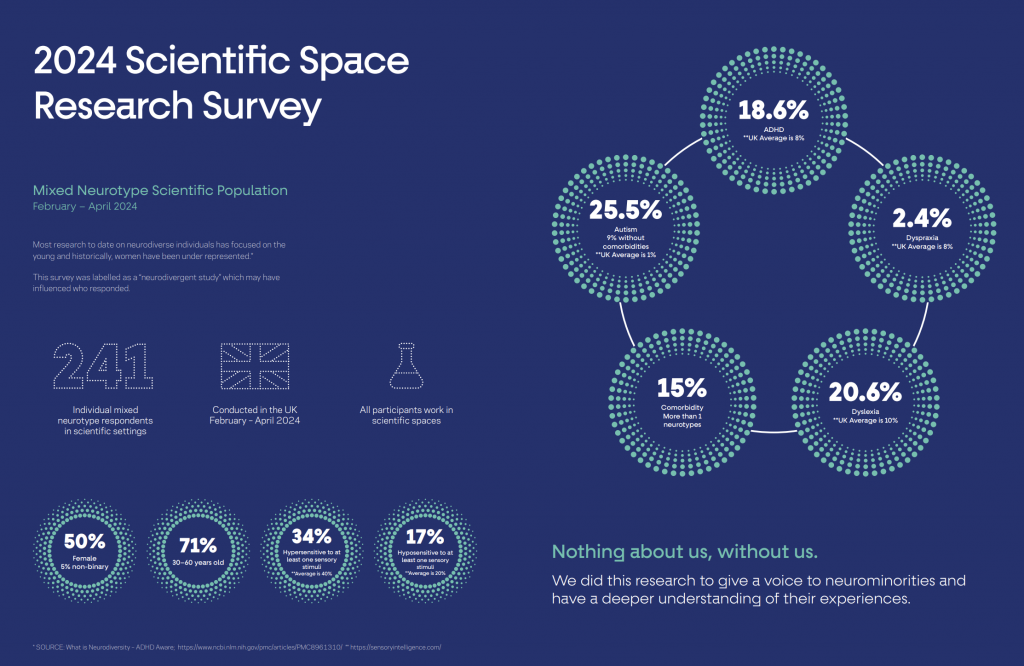In 2025, Kay Sargent, of HOK, is urging workplace design to prioritize sensory stimulation as recent research shows that it could be the root of employee performance and wellbeing.
Have you ever found yourself in a space you couldn’t wait to get out of? Perhaps it was a noisy, bustling work environments with bold images and vibrant colors but no way to orient yourself.
Or perhaps you were assigned to a spot in an open environment that was a sea of identical rows after row of bench seating, where you are right next to a busy corridor, across from a conference room and your back was exposed to all, with no way of see what’s coming up behind you or block the activity around you.
Or perhaps you were assigned a spot in a room that was basically a white box, with strip lighting overhead, limited access to anything humanizing, organic or “real”, with little to no personalization or inspiring elements.
The spaces we occupy have an impact on our mental, emotional and physical health – and in many cases it’s not positive.
Our sensory system is comprised of visual, auditory, tactile, olfactory, gustatory, interoception, proprioception and vestibular senses. Each affects us differently in a variety of ways. Sensory distractions like sounds, smells, and visual clutter can impede our cognitive focus and that can result in a loss of focus, discomfort or general annoyance.
These effects ultimately impact our ability to be engaged and productive while also causing increase presenteeism, stress, burnout and dissatisfaction. It’s worth noting that those are all the things business leaders are trying to address as they are increasingly focusing on employee experience, well-being and positive outcomes for the business and the individual.
But sensory stimulation is impacting everyone within the space, no one is immune to it.
What is troubling for individuals that are less impacted by sensory elements in the built environment can be overwhelming for neurodivergent individuals.
We need to create environments that address sensory stimulation and offer options for those that prefer low sensory threshold spaces, and for those that may need additional sensory stimulation. And the true challenge is to do that in such a way that individuals don’t feel “othered” or isolated but are enabled and empowered. That requires leaning into the science of design, making intentional decisions, and leveraging the elements and principles of design to create neuroinclusive spaces. And it starts with a deeper understanding of how sensory elements are impacting us.
The team at HOK has released our latest research report “Designing Neuroinclusive Laboratory Environments” that we authored in partnership with ARC | Advanced Research Clusters and the University of the West of Scotland. You can download the report and our findings here: https://bit.ly/3XL1nGQ.

Designing for neuroinclusivity is not about creating a competitive advantage, but there is a moral imperative for us to create more inclusive spaces for all, hence we are committed to sharing the research and recommendations with all.
Increased Advocacy for Neuroinclusive Space. Raise you hand if you’re in!
 In Early March 2025, HOK will be launching a comprehensive book on neurodiversity entitled “Designing Neuroinclusive Workplaces.” This book will address sensory processing, cognitive wellbeing and neurodiversity in the build environment and why and how we need to address it to create neuroinclusive spaces.
In Early March 2025, HOK will be launching a comprehensive book on neurodiversity entitled “Designing Neuroinclusive Workplaces.” This book will address sensory processing, cognitive wellbeing and neurodiversity in the build environment and why and how we need to address it to create neuroinclusive spaces.
 In the book, Kay will share the findings from over eight years of research and recommendations for how we as a community can create inclusive spaces. Chapters include Defining Neurotypes, Why it’s Great for Business, Survey Findings, Environmental Influences, Designing for Inclusion and Steps Towards Designing for Inclusion, Design Considerations and the Path Forward. The book includes personal stories, expert interviews and client success stories and is available for pre-order now, https://www.inclusiveworkplace.design.
In the book, Kay will share the findings from over eight years of research and recommendations for how we as a community can create inclusive spaces. Chapters include Defining Neurotypes, Why it’s Great for Business, Survey Findings, Environmental Influences, Designing for Inclusion and Steps Towards Designing for Inclusion, Design Considerations and the Path Forward. The book includes personal stories, expert interviews and client success stories and is available for pre-order now, https://www.inclusiveworkplace.design.
Stay tuned for exclusive looks into the book and its launch!

